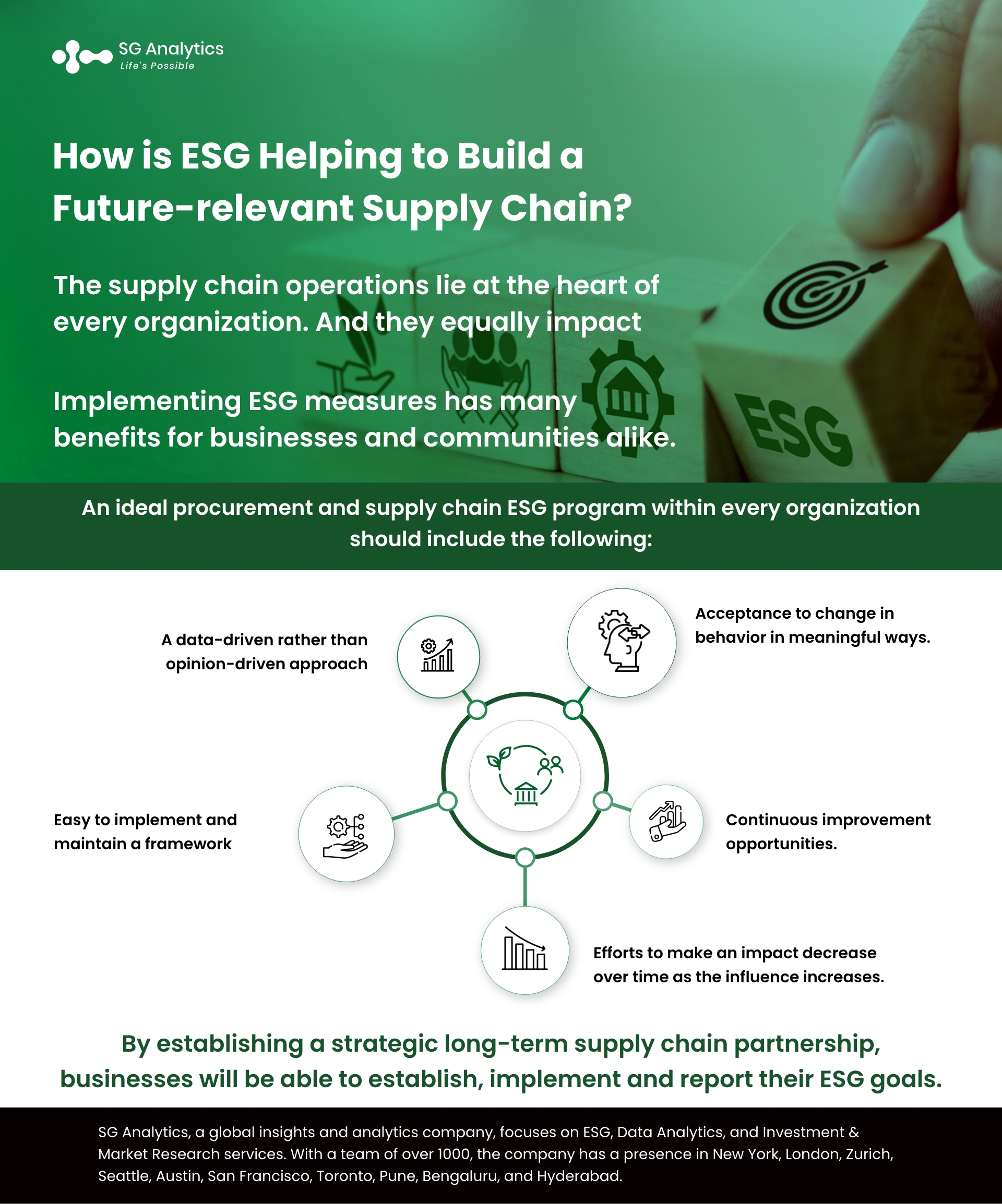Environmental, social, and governance (ESG) is becoming a vital topic of conversation across every sector, and for a good reason. A PwC discovered that 76% of consumers are likely to discontinue relations with organizations that do not comply with sustainable measures.
The supply chain operations lie at the heart of every organization. And they equally impact ESG numbers.
Apart from Scope 1 and 2 emissions, Scope 3 emissions are connected to the operations of a company's suppliers. In the last few years, they have been drawing the attention of analysts as well as fund managers. The EPA reports have highlighted that Scope 3 emissions account for almost 90% of overall greenhouse gas (GHG) emissions. Despite the importance of managing ESG risk across the supply chain, the current mechanisms do not comply with the set standards. It is time for businesses to employ measures to make the process efficient.
Read more: Sustainability Outlook: Top Emerging Trends in 2023 and Beyond

Understanding the Existing Models and Supplier Approaches
Businesses today are deeply intertwined with environmental, social, and governance (ESG) concerns.
-
Consumers are expressing their willingness to shop only for sustainable brands;
-
Investors are in search of more sustainable initiatives
-
Employees are willing to work with companies that instill sustainability into the core of their operations.
Reports claim that almost 90% of Gen X consumers are willing to spend an extra 10% or more when searching for sustainable products. 36% of B2B decision-makers say that a brand's commitment to the environment influences their purchase decisions. Embedding a good ESG framework into a brand's core strategy will help deliver long-term value. By rethinking & redefining business strategy and operational procedures, they can increase and maintain profitability.
Embedding ESG in Supply Chain Operations & Management
When it comes to ESG, businesses need to abide by their commitments to improve their existing operations, thereby actually impacting the communities. However, the tools we use to track ESG are flawed and require serious modification.
Building a sustainable supply chain management system is the top priority for most businesses. With organizations continuing to extend and expand their sustainability programs to encompass the supply chains, they are also looking for assistance with actual implementation. Some of the practical steps of maintaining a sustainable supply chain management system within an organization include:

Step #1: Evaluate
Step #2: Map out people
Step #3: Prioritize company ethics
Step #4: Set measured goals
Step #5: Build process momentum
It is more difficult for businesses to make decisions due to the set restrictions, and many organizations even shy away from relying on ESG as a decision criterion. However, conscious consumerism is emerging as a key trend, and it is gaining momentum.
Read more: Sustainability in Tech: 3 Ways for Companies to Become More Sustainable
For companies to stay relevant, they are continuously striving to evolve and meet the dynamic demands of their customers. A similar approach is the need of the hour to decipher the environmental, social, and corporate governance circumstances. While successful integration of ESG considerations into the supply chain operations mandate several commitments, they also offer a host of benefits, which are-
-
innovation
-
continuous product development,
-
competitive advantages due to sustainability
-
meeting the consumer expectations of being more aware and discerning
A recent study highlighted that almost 58% of employees consider an organization's social and environmental responsibilities when deciding where to work. In the last decade, ESG has transitioned from merely being a way for firms to mitigate environmental risk and demonstrate sustainability compliance into a value-creation tool that reflects their commitment to society. Hence a strong ESG proposition is vital for every business to establish long-term resilience.

The Cycle Approach for ESG Data
An ideal procurement and supply chain ESG program within every organization should include the following:
-
A data-driven rather than opinion-driven approach
-
Easy to implement and maintain a framework
-
Acceptance of change in behavior in meaningful ways.
-
Continuous improvement opportunities.
-
Efforts to make an impact decrease over time as the influence increases.
Today procurement professionals spend hours working on complex and outdated data. Due to this reason, ESG goals often get pushed away. Hence businesses need to take a fresh look at the cycle model, often referred to as the cycle approach. It helps in embedding ESG data into everyday decisions. This implies that preferred outcomes evolve into default outcomes, as ESG criteria are a seamless part of the procurement cycle.
Read more: The ESG Rating Phenomenon: A Guide to Understand ESG Ratings

However, to achieve this approach, businesses must incorporate ESG goals into the ongoing digital transformation and lead with a data-first mindset. Businesses are also integrating AI-driven platforms to leverage this data and automate the decision-making processes, thereby minimizing human error and biases.
By implementing this framework, businesses can use the available data to set realistic benchmarks. This can also aid them in achieving net zero emissions by 2040.
The ESG Transition
Another approach, referred to as the supplier-level analysis, involves tracking how suppliers report and score on ESG issues. The supplier-level analysis is a massive improvement over category-level analysis when it comes to ESG. Scope 3 impact is more on procedures, and it has to do with the operational decisions made by the supplier.
However, the main challenge here is that supplier-level data depends on detailed operational audits. And this can be cumbersome as well as a time-consuming process to implement. Businesses need to include nuance associated with the material that is being procured. The supplier-level ESG data is incredibly complicated, and many procurement professionals often do not have the bandwidth to work with it on a day-to-day basis when making purchasing and sourcing decisions.
Rather than asking for the ESG impact on any category or the annual spend, businesses are approaching a new cycle that asks what the ESG impact of a requisition-to-purchase order is. This helps to identify the spending of one supplier when compared to another option.

This shift to the cycle approach will also require the need to restructure the existing supply chain teams. While earlier, it was the job of a chief sustainability officer to monitor ESG metrics within the organization and propose new solutions. However, with the cycle approach, ESG is becoming an integral part of everyone's job. With the right reporting tools, procurement teams can undertake informed and proficient choices on ESG without spending countless hours analyzing complex or outdated data.
Implementing ESG measures has many benefits for businesses and communities alike. However, only some companies are equipped to tackle these concerns head-on as ESG supply chain programs are often ill-defined, and their real impact becomes weak. With a cycle approach model, businesses can make a real difference without compromising on employee bandwidth.
Read more: Next In: Enterprise Sustainability Investments in Technology
Encouraging ESG integration to Future-proof Supply Chain Crisis
By integrating environmental sustainability, social inclusion, and a good governance strategy, supply chain operations can be accelerated, and new operational, cultural, and financial changes can be initiated to build a future-proof supply chain. It is time for businesses to develop a fair and equitable work environment that fosters a sense of responsibility towards the community.

Businesses are focusing on every vector to promote sustainability in the supply chain operations by establishing energy-efficient workflow, fuel-efficient transportation, eco-friendly packaging as well as circular supply chains to repurpose waste and returns. However, this can only be achieved by establishing effective governance policies and controls that assist them in the true spirit, along with complying with the law and fulfilling stakeholder obligations.
ESG is more than good intentions for all. It is all about creating a tangible plan that helps in achieving real-value results. By establishing a strategic long-term supply chain partnership, businesses will be able to establish, implement and report their ESG goals. Supply chain partnerships will enable them to align their vision for a balanced ESG stance and develop a positive synergy through green supply chains and socially responsible governance to create future relevance.
With a presence in New York, San Francisco, Austin, Seattle, Toronto, London, Zurich, Pune, Bengaluru, and Hyderabad, SG Analytics, a pioneer in Research and Analytics, offers tailor-made services to enterprises worldwide.
A leader in ESG Services SG Analytics offers bespoke sustainability consulting services and research support for informed decision-making. Contact us today if you are in search of an efficient ESG integration and management solution provider to boost your sustainable performance.









